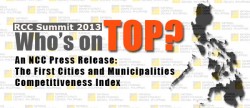- Home
- |
- About Us
- |
- Working Groups
- |
- News
- |
- Rankings
- WEF-Global Competitiveness Report
- Ease of Doing Business Report
- IMD-World Competitiveness Yearbook
- TI-Corruption Perceptions Index
- HF-Economic Freedom Index
- WEF-Global Information Technology Report
- WEF-Travel and Tourism Report
- WIPO-Global Innovation Index
- WB-Logistics Performance Index
- FFP-Fragile States Index
- WEF-Global Enabling Trade Report
- WEF-Global Gender Gap Report
- Gallery
- |
- Downloads
- |
- Contact Us
NCC Releases Results of First Cities and Municipalities Competitiveness Index

The National Competitiveness Council (NCC) presented today highlights from its 1st Cities and Municipalities Competitiveness Index at the Regional Competitiveness Summit held at the Intercontinental Hotel, Makati.
The Cities and Municipalities Competitiveness Index presents economic development and competitiveness indicators at the local government levels. Constructed by the NCC together with the United States Agency for International Development under the INVEST Project, the Index is composed of roughly 30 weighted indicators measuring Economic Dynamism, Government Efficiency, and Infrastructure.
Out of the 122 cities and 163 municipalities included in the report, Cagayan de Oro City, Misamis Oriental was ranked the most competitive city overall. Rounding out the top five cities were Iloilo City, Iloilo; San Fernando, Pampanga; Butuan City, Agusan del Norte; and Bacolod City, Negros Occidental. The most competitive municipality was San Francisco, Agusan del Sur, followed by Guagua, Pampanga; Carmona, Cavite; Daet, Camarines Norte; and General Trias, Cavite.
While more than half of the top 50 cities and top 50 municipalities were located in Luzon, it is interesting to note that the highest-ranked city and municipality were both in Mindanao. The results indicate that government initiatives to harness the potential of the Mindanao region are on the right track. At the Mindanao Development Forum held last February in Davao, Socioeconomic Planning Secretary and National Economic Development Authority Director General Arsenio M. Balisacan said that Mindanao “could spur higher growth for our country and contribute immensely in the attainment of the inclusive development agenda”.
The Index also ranked the cities and municipalities by three main factors. The first, Economic Dynamism, collects figures on business registration, employment, and financial institutions, among others. For this factor, the top three cities were Quezon City; Koronadal, South Cotobato; and Marikina City. The top municipalities were Calasiao, Pangasinan; San Nicolas, Ilocos Norte; and Sta. Cruz, Laguna.
The second factor, Government Efficiency, tracks transparency and accountability, public finance, performance recognition, business responsiveness, and basic government services. The top cities in this category were Iloilo City, Iloilo; Bacolod City, Negros Occidental; and Cagayan de Oro City, Misamis Oriental. The best municipalities were Kabugao, Apayao; Pontevedra, Capiz; and Nueva Valencia, Guimaras.
Lastly, the Infrastructure category gathers data on indicators such as road network, basic utilities, and registered vehicles. The top cities were Naga, Camarines Sur; San Fernando, Pampanga; and Cagayan de Oro City, Misamis Oriental. The top municipalities were Daet, Camarines Norte; Mexico, Pampanga; and Virac, Catanduanes.
Present during the Summit were members of the Regional Competitiveness Committees organized by the NCC to track competitiveness indicators, formulate programs to improve competitiveness, and engage in investment promotion activities to attract investors and create jobs. RCC members include representatives from the public and private sectors and the academe.
The Summit ended a two-day event which began with orientation meetings for RCC representatives on Business Permits and Licensing System Streamlining and Business Risk Assessment and Management of Climate Change Impact. The meetings were conducted on July 29 by the International Finance Corporation and the World Wildlife Fund, respectively, as part of the capacity-building programs for the RCCs. Prior to the Summit, there was also a workshop where the RCCs discussed possible areas for improvement in data collection and analysis of the Competitiveness Index.
The NCC will be conducting the report annually to provide LGUs a means to evaluate performance and formulate development plans. According to NCC Private Sector Co-Chairman Guillermo M. Luz, the report will not only provide potential investors with information on cities and municipalities but also enable local governments to better manage themselves. Based on the indicators, local governments can now benchmark their performance against each other and eventually against other cities in the ASEAN.
Department of Interior and Local Government Undersecretary Austere A. Panadero also discussed the Seal of Competitiveness to encourage LGUs to become more business-friendly and competitive. For his part, Department of Trade and Industry Secretary and NCC Chairman Gregory L. Domingo emphasized the need for collaboration between the national and local governments, as well as the public and private sectors, in fine-tuning a comprehensive national competitiveness plan.
The rankings were based on data voluntarily submitted by Regional Competitiveness Committees on the cities and municipalities in their respective regions.

